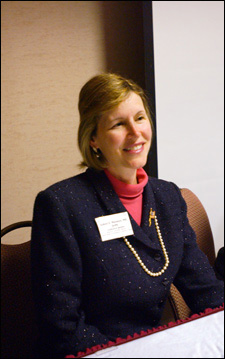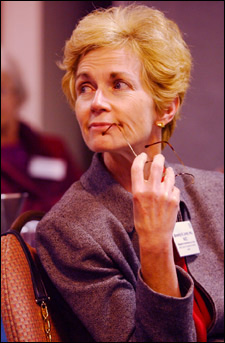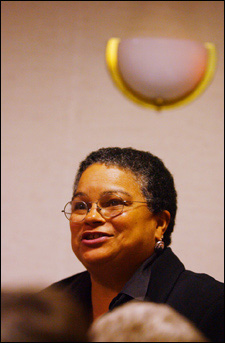Women’s Health Conference spotlights HRT:
Tangled tale of hormone therapy is teased into clarity at conference



At a recent conference, Professor of Medicine JoAnn Manson (right) spoke to a rapt audience of colleagues about hormone replacement therapy – and its fascinating, troublesome history. Among the participants in the conference were Judy Ann Bigby (center), director of HMS’s Center of Excellence in Women’s Health, sponsor of the conference, and Beverly Lorell (left), research committee co-chair of the center. (Staff photos by Kris Snibbe)
Hormone replacement therapy (HRT) for the symptoms of menopause, a hot topic since research found it more risky than beneficial this past summer, took center stage at the third annual Women’s Health Research Conference of Harvard Medical School’s Center of Excellence in Women’s Health on Oct. 9.
Yet the conference went beyond the headlines to explore the history and future of HRT: Why was it assumed to protect women from heart disease in the first place, and how can they cope without it?
“The hormone replacement therapy saga is truly a dramatic and distressing strange story,” said JoAnn Manson, professor of medicine at the Medical School (HMS) and a principal investigator of the Women’s Health Initiative study on HRT.
Manson gave a brief history of HRT, explaining why millions of women were using it for its presumed preventive powers over heart disease. Women were already using estrogen therapy by 1966, when gynecologist Robert Wilson promoted it in his book “Feminine Forever,” claiming that by using estrogen during menopause, “women will be much more pleasant to live with and will not become dull and unattractive.”
By the 1970s, when a combination of progestin and estrogen became the popular hormone replacement therapy, its use skyrocketed. Initially used only to treat symptoms of menopause, HRT was found to prevent bone loss, a health risk to post-menopausal women.
But even more compelling was evidence, supported by observational studies but not rigorous research, that HRT decreased a woman’s risk of heart disease, the leading cause of death for women. Even the news in the early 1990s that estrogen could increase the risk of breast cancer did little to diminish the popularity of HRT.
“It was, without question, a beautiful hypothesis that estrogen treatment would prevent heart disease,” Manson said.
The Women’s Health Initiative shot down this “beautiful hypothesis” in a randomized, controlled study. In June 2002, just over halfway through its trial, the initiative ceased its study of estrogen and progestin on healthy women, citing health risks that outweighed benefits. HRT was found to increase the risk of breast cancer as well as heart disease and stroke, overshadowing the benefits of lowered risk of colorectal cancer and hip fractures.
Illustrating her talk with an array of slides and graphs, Manson interpreted the data and gave a glimpse of some early findings from continued examination of study results, which further segments the study participants by age and body mass index to determine whether risks are greater for some groups.
She did not anticipate that conclusions would change, and in fact she stated that indications were that further analysis may reveal that risks are even greater. When women in the study who were noncompliant – who for some reason stopped the therapy – are factored out, for instance, the risks may come into sharper focus.
“It’s really not a pretty story when you look at it on a populationwide basis,” said Manson.
Real women, real alternatives
Kathryn Martin, assistant professor of medicine at HMS and director of the Reproductive Endocrine Associates at Massachusetts General Hospital, picked up on one of Manson’s final thoughts: While HRT does more harm than good when used long term to prevent heart disease or bone loss, it may still be appropriate for treating menopause symptoms like severe hot flashes.
To the audience of mostly researchers, Martin described some real-world scenarios of menopausal women she has treated.
Estrogen therapy, she said, is “the absolute gold standard” for the treatment of vasomotor flushes – hot flashes – and genitourinary atrophy, which can cause pain with intercourse and vaginal dryness.
While some have been tempted to downplay the severity of these symptoms, she said, “anybody who’s had a lot of hot flashes will tell you it’s a really big deal.” Because they come more often at night, severe hot flashes can result in insomnia-related symptoms.
Giving examples of several patients who came to her in a panic after July’s news from the Women’s Heatlth Initiative study, Martin illustrated the range of alternatives to long-term HRT.
She could recommend short-term HRT, ranging from six months to four years, to treat severe symptoms of women who had not had breast cancer and who had no history of coronary disease. She also outlined alternative therapies, such as antidepressants to relieve hot flashes or topical estrogen for genitourinary atrophy.
The Women’s Health Research Conference, which aims to highlight research in women’s health and gender biology and provide researchers with an opportunity to learn about each other’s work, also spotlighted several in-progress studies that received funding from the Harvard Medical School Fund for Women’s Health.
Francine Welty, director of cardiovascular care for women at Beth Israel Deaconess Hospital, presented ongoing research on the effects of soy on blood pressure and cholesterol in menopausal women. Janet Rich-Edwards, assistant professor at HMS and instructor at the Harvard School of Public Health, is exploring the high rates of infant mortality among black immigrants in Worcester.
Addressing another focus of the conference – identifying and removing barriers to the promotion of women faculty and researchers – Joanne Ingwall, HMS professor of medicine and vice chair of faculty development in the department of medicine at Brigham and Women’s Hospital, gave a talk called “The Nuts and Bolts of HMS Promotions of Women.”




